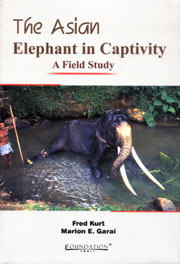Book contents
- Frontmatter
- Contents
- Preface
- Acknowledgments
- 1 Introduction
- 2 The Sri Lankan Elephant
- 3 The Captive Populations, Keeping Systems and Health
- 4 Food, Tool Use and Sleep
- 5 Musth, Reproduction, Social Integration and Stereotypy
- 6 Captive Elephants and Conservation
- 7 Base Lines and Proposals
- Appendix I
- Appendix II
- References
- Photo Gallery
- Index
3 - The Captive Populations, Keeping Systems and Health
Published online by Cambridge University Press: 05 February 2012
- Frontmatter
- Contents
- Preface
- Acknowledgments
- 1 Introduction
- 2 The Sri Lankan Elephant
- 3 The Captive Populations, Keeping Systems and Health
- 4 Food, Tool Use and Sleep
- 5 Musth, Reproduction, Social Integration and Stereotypy
- 6 Captive Elephants and Conservation
- 7 Base Lines and Proposals
- Appendix I
- Appendix II
- References
- Photo Gallery
- Index
Summary
The Pinnawela Elephant Orphanage and its Elephants
The Pinnawela Elephant Orphanage is situated in the Kegalle District, some 80 km northeast of Colombo, north of the city of Kegalle, or about half-way between Colombo, the present capital of Sri Lanka, and Kandy, the last of several historical capitals of the country. The orphanage was established in 1975 with the aim to give young orphaned elephants, which are found on the island, a safe home. In 1978 the orphanage was taken over by the National Zoological Gardens from the Department of Wildlife Conservation. The orphanage encompasses an area of about 9 ha of mainly coconut plantations. With a population of 70 captive elephants in 2002 the Pinnawela herd is one of the largest permanent concentrations of captive Asian elephants in the world next to the camp of Maesa in Thailand's Chang Mai Province with 85 elephants in 2000 (Tipprasert, 2002) and the Temple of Guruvajoor in Kerala with about 65 elephants in 2002.
Population and population fluctuation
In 1975 the Pinnawela population consisted of 10 elephants, in 1986 there were 32 elephants, 53 in 1993, 56 in 1997, 64 elephants in 1998 (Kurt, 2001a), and 70 in 2002 (Rajapaksa et al., 2002). Between 1983 and 2003, 22 elephants were born at Pinnawela by 8 orphaned and 3 captive born females. One of the males was born in the Dehiwala Zoo in 1991.
- Type
- Chapter
- Information
- The Asian Elephant in CaptivityA Field Study, pp. 48 - 85Publisher: Foundation BooksPrint publication year: 2006



